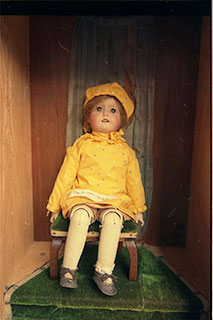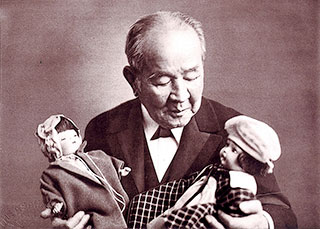公開日 2021年11月12日
Blue-eyed Friendship Doll in Oyama Elementary School
1. Introduction

- Ruth Jane
In the early spring in 1927 (the second year of the Showa period), 12,739 friendship dolls were sent as a goodwill mission by the children in the U.S. to those in Japan, in time for Hina Matsuri (Doll Festival), which is celebrated in Japan on March 3rd. The dolls were welcomed and got commonly known as ‘blue-eyed dolls’, which is the title of the children’s song (words by Noguchi Ujo, music by Motoori Nagayo), released in 1921, which happened to be popular at that time.
As the relations between Japan and the US got worse afterwards, however, the original objective of the friendship dolls was forgotten, and during the Asian Pacific War, many of the blue-eyed dolls, labeled as ‘enemy dolls’, disappeared, after thrown away, burnt, pierced by bamboo spears or pulled apart, in front of the children’s eyes. Even under such circumstances, however, some people, distressed by the miserable situation of the dolls, who they claimed were totally innocent, protected the dolls by hiding them in the cabinets, closets or storage sheds.
After the war ended, the memories of the blue-eyed friendship dolls were almost gone. In 1973, when almost 30 years had passed since the end of the war, a blue-eyed doll suddenly presented itself in Tone-higashi Elementary School in Gunma Prefecture. The doll had been kept safe in secret by an ex-teacher of the school. This incident was broadcast by NHK with the title of ‘Doll Ambassador, Mary’, which caused the successive discoveries of the blue-eyed dolls all over Japan. ‘Doll Protecting Associations’ were organized throughout Japan, which promoted the investigation and the research about the dolls. As the result, up to March 2007, 321 dolls were identified as the blue-eyedfriendship dolls in Japan, 12 of which have been kept in Kanagawa Prefecture. Among them is ‘Blue-eyed Doll, Ruth Jane’, kept in Oyama Elementary School in Isehara City, though its presence has remained rather unknown. First, let’s review the outline of the relations between Japan and the US in those days.

- Eiichi Shibusawa with two friendship dolls
- (photo:owned by Shibusawa Memorial Museum)


